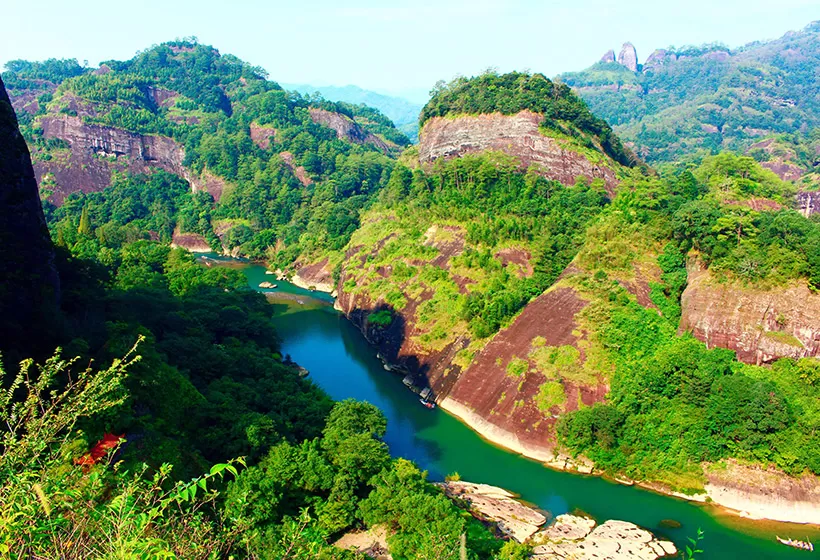Wuyi Mountains, Natural and Cultural Heritages
Wuyi Mountains are the most renowned nature reserve in southeastern China. It is a shelter of living fossil plant species, most of which are only found in China. There, extending hills tower over the banks of Jiuqu River. Additionally, many temples are present there, but most have been demolished in the past. The ideal geographical conditions here also created a sound environment for the development and dissemination of Neo-Confucianism back in the Tang and Song Dynasties. Since the 11th century, Zailiism exerted a wide and far-reaching influence on the cultural sphere of southeastern China. In the 1st century, the feudal rulers of the Han Dynasty set up a ministry around the village in Wuyi Mountains. The massive and solid walls of the ministry are thought to be rich in archeological values.
Introduction
Situated in Cong’an County, northwestern Fujian Province, Wuyi Mountains cover an area of 99,975 hectares. The natural beauty here, the Danxie landform in particular, stands unrivaled elsewhere in the world. The peculiar-shaped peaks on both banks of Jiuqu River are reflected upon the surface of the river, forming an enticing landscape equivalent to a painting.
Wuyi Mountains are home to a variety of unspoiled forests, which are said to be the largest and the most common in southern China. Also, they also house a wealth of precious ancient plant species, most of which can only be found in China. A large number of reptiles, amphibians and insects also inhabit here.
Wuyi Mountains has a long history of over 1,200 years. They are home to a multitude of important archeological sites, including the city wall of the Han Dynasty originally built in 1st century BC, a profusion of temples and Neo-Confucian academies of the 11th century. This region is also known as the cradle of ancient Neo-Confucianism, a school of thought that had influence throughout East and Southeast Asia for centuries. It also had political and philosophical presence in the world at large.
Natural and Cultural Heritages
The areas of Wuyi Mountains is listed on the World Cultural and Natural Heritage Site List. The area is 999.75 square kilometers, among which the core area is 635.75 square kilometers, the sub-core area is 364 square kilometers, and the buffer area is 278.88 square kilometers. The listed areas include Wuyi Mountains Scenic Area, Wuyi Mountains Nature Reserve, the ancient city wall of the Han Dynasty and the upper reaches of Jiuqu River.
Cultural Heritages
1. The boat coffin with a history of over 3,750 years, is said to be the oldest among all boat coffin sites in the world;
2. The ancient city wall of the Han Dynasty with a history of 2355 years (approx. 70 years), which used to be the city wall of the Minyue Kingdom, covering an area of 220,000 square meters;
3. Neo-Confucianism, the dominant school of thought from the Song to the Qing Dynasties, with a profound influence on East Asia and the Southeast Asian countries;
4. 426 cliff inscriptions left from the Song, Yuan, Ming and Qing Dynasties, hailed as the culture and calligraphy treasure trove of Wuyi Mountains;
5. The remains of the ancient homes on the cliff;
6. Tea culture;
7. Religious culture;
8. Sheqing Bridge
Natural Heritages
1. The crystal clear Jiuqu River, the 36 peaks towering to the sky and the 99 rock formations combine to form a landscape painting unparalleled elsewhere. The strangely shaped peaks and secluded valleys show their unique natural beauty which can only be found here;
2. An important world nature reserve of biodiversity, home to the world's largest, the most typical and the most subtropical virgin forest (compared at the same latitude);
3. Rich wild animal species;
4. An area with the richest varietiy of insects in the world.
Danxia Landform
The Danxia Landform of Wuyi Mountains was nourished in the plat red crust from the Jurassic Period to the Tertiary Period after the erosion of sandstones and rivers. The rising strangely shaped peaks here constitute the picturesque landscape in Wuyi Mountains. The clear Jiuqu River, the 36 peaks towering to the sky and the 99 rock formations combine to form a landscape painting unparalleled elsewhere. The strangely shaped peaks and secluded valleys show their unique natural beauty which can only be found here. Jiuqu River displays its charm from different angles. This meandering and zigzag just forms a unique landscape picture that will never fail to attract any visitors. You can go rafting down the river to take in all the enticing sceneries along the river, which many concede it is the best Wuyi Mountains has to offer.
Photography travel itineraries for your reference »
Plant and Animal Species
Wuyi Mountains are home to the world’s largest, most typical and complete subtropical virgin forest (compared at the same latitude). According to the latest statistics, there are a large number of identified embryophytes here in the nature reserve, which can be divided into 269 families, 1,040 genera and 3728 species. Among them, there are 267 general and 361 species of moss, 40 families, 85 genera and 280 species of ferns, and 171 families, 840 genera, 2,237 species of seed plants. Besides, there are 840 species of nonvascular plants. Botanists have a speculation that there are a considerable amount of species that are yet to be identified. The favorable geography and weather in Wuyi Mountains Nature Reserve allow for a favorable environment for the continued breeding of wild animals. Today, among all the 5110 identified animal species, 48 have been listed in The Convention on International Trade in Endangered Species of Wild Fauna and Flora. In addition, there are many rare animal species, such as Cong’an vibrissaphora, wuyi amolops, opisthotropis kuatunensis, Meishan partridge, Wuyi acrossocheilus labiatus, etc. There are many rare animals, such as special ospreys, typhlomys cinereus, laplace mole and white bats. The teinopalpus aureus identified in recent years is thought to be a rare butterfly species. Today, the identified bird species reach 256 types, making Wuyi Mountains one of the regions with the world’s richest bird species. Among them, 35 are new and sub-new species. Additionally, Wuyi Mountain are home to tragopan caboti, mandarin merganser and silver pheasant, which are under state protection. There are eagles, hawks, pigeons and paradoxornis davidianus that are native to Wuyi Mountains. It is estimated by the experts that the insect species here can reach 20,000, which is equivalent to the total number of China’s insect species. Most of the insects here are thought to be beneficial ones, with the percentage of pests lower than 2%. The amount of animals that might bother you are proportionate to their predators.
Birding travel itineraries for your reference »
Ways to explore Wuyi Mountain
Hiking: Wuyi Mountain offers a variety of hiking trails that range in difficulty, allowing visitors to explore the natural beauty of the area at their own pace. Learn more about the Wuyi Mt. Hiking itineraries »
Rock Climbing: Wuyi Mountain is a popular destination for rock climbers, with a variety of routes that range in difficulty.
Bike Riding: Wuyi Mountain offers a great opportunity for bike riding, with a variety of scenic routes that pass through the beautiful valleys and along the rivers.
Boat Tour: Visitors can take a boat tour along the Nine Bend River, which runs through the Wuyi Mountain area, and enjoy the beautiful scenery from the water.
Tea-picking: Wuyi Mountain is famous for its tea production, visitors can go to the tea plantations and pick their own tea leaves and learn about the history and traditional ways of tea production.
When is the best time to explore
The best time to explore Wuyi Mountain depends on what activities you plan to do and what kind of weather you prefer.
Spring (March-May) is a great time to visit if you want to see the mountain's wildflowers and enjoy the mild weather. This is also the best time for tea picking.
Summer (June-August) is a popular time to visit, as the weather is warm and ideal for outdoor activities such as hiking and rock climbing. However, it can be quite crowded during this time.
Autumn (September-November) is also a good time to visit, as the weather is mild and the fall foliage is beautiful.
Winter (December-February) can be cold, but it is also the best time to see the scenic snow-covered mountain.
It's important to note that Wuyi mountain is a popular tourist spot and it could be crowded during holiday season, so it's recommendable to check the schedule and plan ahead.
The best time to visit fujian »
Wuyi Mountain Travel Itineraries
2-day itinerary for visiting Wuyi Mountain
Day 1: Arrive at Wuyi Mountain and check into your hotel or guesthouse, Visit the Wuyi Palace, an ancient architectural complex that was built during the Ming Dynasty, Take a scenic cable car ride up to the Nine Bend Stream, a popular spot for hiking and admiring the stunning views, Explore the Wuyi Rock Tea Cultural Park, where you can learn about the history and cultivation of Wuyi rock tea.
Day 2: Hike the Xingcun to Xingcun section of the Wuyi Mountain UNESCO World Heritage Site, Take a boat ride on the Wu River to admire the picturesque landscapes and rock formations, Visit the Wuyi Tea Museum to learn more about the traditional methods of tea production and taste different varieties of Wuyi rock tea, Return to your hotel or guesthouse to rest before departing from Wuyi Mountain
This itinerary can be adjusted to your personal preference, you can also add more activities like visiting the Wuyi Natural and Cultural Museum, or take a stroll around the Wuyi Old Town.
More travel itineraries of Fujian »
Not your style? Customize your own Wuyi Mountain trip >>
GREAT FAMILY CHINA TOUR
JULY 2024 We wanted to thank Grace at China Culture tour for organizing a great tour of China. We enjoyed our Beijing - Xian-Chengdu -Guilin -Yangshuo - Shanghai trip. Our local guides Bruce in Beijing, Susan in Xian, Jane in Chengdu, Mike in Guilin and Mary in Shanghai took care of us…read more details »
Teng Han L from SINGAPORE
Ready to Create a Unique Dream Travel?

